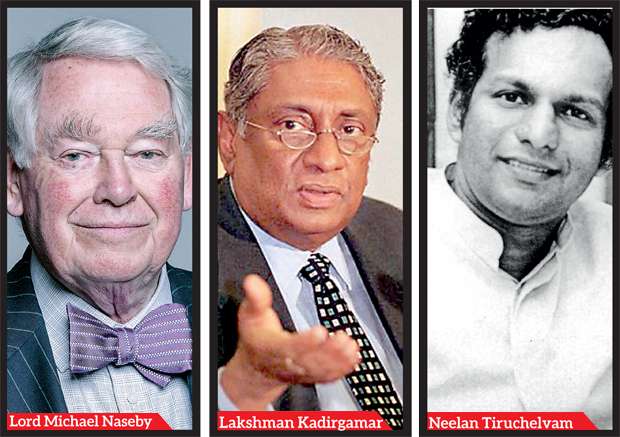Reply To:
Name - Reply Comment
Last Updated : 2024-04-20 00:00:00




ecent revelations on the detailed course of Eelam War IV in its last phase in 2009 made possible by Lord Michael Naseby’s extraction of the contemporary readings of the battle theatre provided by the British Military Attache in Colombo, Lt. Col. Gash, permits one to chart specific strands of deceit and conspiratorial design perpetuated by the Western states led by USA and Norway with the implicit or explicit participation of a host of humanitarian agencies, such as ICG, AI and HRW together with other foreign funded agencies in Colombo.
This is a serious charge based on a series of articles that I have written over the years and recently consolidated after the Gash reports were made available by Lord Michael Naseby. However, a fuller comprehension of the specific strands of criticism requires attention to the character of the de facto state of Thamil Ealam set up by the LTTE in 1990 after its successful guerrilla battles with the IPKF from 1987-89 and its seizure of swathes of territory in the Eastern Province in 1990.
The LTTE as an organization in its initial phases was imprinted with the demands of a nationalist insurgency in competition with other Tamil militants – all pitted against the existing state of Sri Lanka. Central to the LTTE was the mind-set guiding one of its key founding fathers: Veluppillai Pirapāharan (1954-2009).Pirapāharan was totally committed to the goal of independence for his people, the SL Tamils. He was ready to lay down his life for this goal; while demanding the same depth of sacrificial devotion from all those who joined the LTTE. Their induction oath ran thus:
“Our revolutionary organization’s purified aim is for a free society to achieve Tamil Eelam. My life and soul and all this I sacrifice to our organization’s leader Prabhakaran. We fully accept that for him we will be very faithful and trustworthy.The aim of the Tigers – Tamils’ freedom.”
As one of his early comrades-in-arms Raghavan has indicated, Pirapāharan was inspired in his youth by the tales surrounding Indian nationalist heroes such asSubhas Chandra Bose and Kattabomman. Furthermore, he was an admirer of Adolf Hitler because of an erroneous belief that Hitler was the force behind the initial successes of the German Army. Military manuals by Sun Tzu and Clausewitz were also among his voracious acquisition of knowledge via translations or summaries provided by friends.
As a youngster, moreover, Pirapāharan had been an addict of action movies from Tamil Nadu and the West. Ganeshan Iyer, one of the early Tiger leaders of the mid-1970s, has stated that Pirapāharan admired the exploits of Clint Eastwood in his role as uncompromising executor of righteous vengeance in several cowboy films. As Iyer indicates, this meant that Pirapāharan reached for the gun whenever serious internal disputes emerged within the tiny, clandestine core of Tiger militants working underground in the late 1970s and 1980s. At least two Tigers, one Michael from Batticaloa and one Patkunarajah, were killed (and he later directed one of his cadres to assassinate Uma Maheswaran who had broken away and formed PLOTE).
"Motives of retribution combined with tactical strike towards immediate strategic goals can be discerned in the assassination of both Neelan Tiruchelvam and Lakshman Kadirgamar"
As several Tamil militant organizations competed for leadership of the Tamil nationalist struggle, the Tiger leaders proceeded to eliminate or nullify TELO, EROS, PLOTE and EPRLF by force of gun and intimidation (between 1985 and 1991). Once Thamil Ealamwas in place in 1990, Pirapāharan adhered to the same tactic. It was now more than tactic. It was tactics aligned to strategy. Eliminate all leaders (including Tamils) opposed to Pirapāharan and eliminate leaders standing in the way of Thamil Ealam.
The concepts “tactic” and “strategy” are often used interchangeably in discussions of business goals. In the military arena strategy refers to “the planning and general direction of military objectives, while tactics seek “to implement strategy by short-term decisions … on the field of battle.” Thus, in both arenas it is understood that the two concepts work in tandem: “strategy” defines the overall goal or goals; while “tactics” defines the minutiae of paths towards one or more of these goals.
Pirapāharan and the LTTE leadership consistently deployed one tactic: target key military and political leaders within the opposing government of Sri Lanka and eliminate them by deploying suicide assassination teams, roadside bombs, snipers or in-your-face killers. They also intervened in parliamentary or presidential elections in the south by seeking to eliminate a candidate deemed less favourable to the Eelam cause.
Let me initially point to the ultra-long list of assassinations carried out so effectively by the LTTE – a roll-call so long that I point readers to Wikipedia for edification. One can also speculate on the LTTE motives by differentiating killing-acts of vengeance from those seeking to promote future short-term or long-term goals whenever such a distinction becomes pertinent.
The assassination of Rajiv Gandhi on May 21, 1991 is a conundrum of sorts. The killing was clearly designed to prevent the Congress Party from returning to power in India. But it seems to have been an act of vengeance as well -- revenge for the manner in which the IPKF did not meet the LTTE’s initial expectations and then resorted to a war that saw the demise of several of Pirapāharan’s original comrade-in-arms. That the Tiger hierarchy and aides in Tamil Nadu and Lanka compiled a document entitled The Satanic Force in order to make their case against Gandhi supports this conjecture.
Motives of retribution combined with tactical strike towards immediate strategic goals can be discerned in the assassination of both Neelan Tiruchelvam and Lakshman Kadirgamar. To Pirapāharan, of course, both would have been turncoats: Tamils serving the enemy.
However, there were substantial strategic gains for the LTTE in each act of assassination. Neelan Tiruchelvam of the TULF was working with Chandrika Kumaratunga and G.L. Peiris to frame a constitutional via media that was designed to win over moderate Tamil opinion at a stage when Presidential elections were looming at the end of 1999. The assassination was at once symbolic and tactical. Its timing in late July 1999 was a stark reminder of the July pogrom of 1983 that terrorized so many Tamils living in the south. It was also a warning to Tamil peaceniks everywhere and a severe threat to the remnant elements of the old TULF.
As a tactic Neelan’s assassination had a resounding strategic impact: it was one step in the process whereby the TULF of old disintegrated and converted into a pliant body of Tamil politicians in the south assembled under a new name, viz. the Tamil National Alliance – a body that even adopted the Tiger salute with its Nazi connotations.
"Ganeshan Iyer, one of the early Tiger leaders of the mid-1970s, has stated that Pirapāharan admired the exploits of Clint Eastwood in his role as uncompromising executor of righteous vengeance in several cowboy films"
Likewise, the assassination of Lakshman Kadirgamar on August 17, 2005 was a tactical precursor to the renewal of war after the ceasefire of 2001. To comprehend this argument, one must step back to 2001/02.
The ceasefire brought Norway into the Sri Lankan scenario in a major way with Eric Solheim as its key diplomat and Anton Balasingham as the LTTE ‘magician.’ The LTTE moved on to the world stage as a de facto state in the period 2001-06. A media function at Kilinochchi in April 2002 was a world event. LTTE delegations thereafter visited western capitals and Norwegian ministers paid state visits to Thamil Ealam.
When I visited Kilinochchi in late November 2004 to witness the maaveerar homage ceremonies held every November 26, several Tamil public servants whom I met were feisty and keen on war. Moreover, a chance ethnographic finding provided me with definitive indications that the LTTE was preparing to renew its warring path: the goal was to wrest an independent state of Thamil Ealam by force of arms.
The impact of the tsunami of December 26, 2004 (which decimated the Sea Tiger capacities in particular) delayed this move to battle. So, it was not till mid-2006 that Pirapāharan and his comrades ventured into battle. From their viewpoint the ground had been prepared in the West for a military push to finalize the international recognition they had secured as a state in the wings.
One major obstacle stood in their way on the international stage: that forceful Tamil man Lakshman Kadirgamar. A consummate speaker with wide-ranging international connections, Kadirgamar was a thorn in the Norwegian flesh. The sooner got rid of the better. Ingenious LTTE planning and a dysfunctional Royal-College Tamil household in the heart of Colombo 7 enabled a Tiger sniper to eliminate Kadirgamar on August12, 2005. This act of killing was a tactical ploy towards the strategic goal ofThamil Ealamthrough war in mid-2006 – conceived with assurance and determination by the Tiger leaders as successful war. That success did not eventuate in Eelam War IV was in part due to the failure of two other tactical strikes: namely, the assassination attempts on General Sarath Fonseka on April 25, 2006 and that on Gotabhaya Rajapaksa on December 1, 2006. A pregnant suicide bomber in fact penetrated SL Army HQ and wounded Fonseka; but he recovered and led the SL Army during Eelam War IV. The Sri Lankan government’s success in containing and then squashing the LTTE in Eelam War IV (2006-09) was due to a constellation of many factors. However, the organizational and leadership capacities revealed by Gotabhaya Rajapaksa and Sarath Fonseka were of considerable significance in producing this outcome. Thus, the failure of those two assassination strikes had a disastrous impact for the Tiger programme of war.
These two failures, ironically, support the thesis that Pirapāharan’s persistent resort to assassination was a tactic that was integral to LTTE strategy – even, arguably, to the degree of serving as a strategy itself.
Gos Wednesday, 01 August 2018 07:39 PM
Well, what an eye-opener ! Ranil/ Mangala and LTTE diaspora rump now masquerading as Human Rights advocates should hang their heads in shame. Still trying to justify and working in cohort with the same Western forces to disintegrate the island of Sri Lanka.

Add comment
Comments will be edited (grammar, spelling and slang) and authorized at the discretion of Daily Mirror online. The website also has the right not to publish selected comments.
Reply To:
Name - Reply Comment
On March 26, a couple arriving from Thailand was arrested with 88 live animal
According to villagers from Naula-Moragolla out of 105 families 80 can afford
Is the situation in Sri Lanka so grim that locals harbour hope that they coul
A recent post on social media revealed that three purple-faced langurs near t